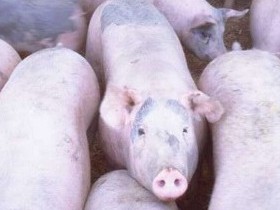Cereal type, beta-glucans and enzymes in pigs

Two experiments were conducted at Lyons Research Farm in Dublin, Ireland to investigate the effects of cereal type, ß-glucan type and exogenous enzyme supplementation (ES) on microbial populations, volatile fatty acid (VFA) concentrations, nutrient digestibility, indole and skatole levels in the digesta and mineral metabolism in pigs.
In Experiment 1, 28 boars were fed one of 4 dietary treatments:
T1) barley-based diet;
T2) barley-based diet plus ES;
T3) oat-based diet and
T4) oat-based diet plus ES.
The ES used in both experiments contained endo-1,3-β-glucanase and endo-1,4-β-xylanase.
Results Exp. 1
In Experiment 1, pigs offered barley-based diets had higher coefficient of total tract apparent digestibility (CTTAD) of organic matter (OM) and gross energy (GE) and lower CTTAD of nitrogen compared to oat-based diets.
Pigs offered barley-based diets had higher molar proportions of butyric and propionic acids and higher total VFA concentrations in the caecum and colon than pigs fed oat-based diets.
Pigs offered oat-based diets had higher populations of Bifidobacteria in the ileum and colon, and Lactobacilli in the colon compared with pigs fed barley-based diets.
Glucans effect
In Experiment 2, 28 boars were also fed one of 4 dietary treatments:
T1) oat-based diet containing endogenous (non-purified) β-glucans;
T2) oat-based diet containing endogenous β-glucans plus ES;
T3) wheat-based diet and exogenous (laboratory purified) β-glucans and
T4) wheat-based diet and exogenous β-glucans plus ES.
The laboratory purified exogenous β-glucans used in Experiment 2 were oat-derived β-glucans.
The diets were equalised to have similar amount of total β-glucan and arabinoxylan.
Results Exp. 2
In Experiment 2, pigs offered diets containing endogenous β-glucans without ES had higher populations of Bifidobacteria compared to pigs offered diets supplemented with exogenous β-glucans without ES.
Diets containing endogenous β-glucans without ES had a lower CTTAD of organic matter and gross energy compared to diets supplemented with exogenous β-glucans without ES.
Conclusion
Barley-based diets have more beneficial effects on parameters related to gut health than oat-based diets; however oat-based diets exhibit higher potential to enhance beneficial microbial populations.
Endogenous β-glucans show better prebiotic properties than exogenous β-glucans.
The full research report can be obtained from ScienceDirect











